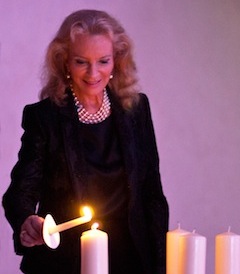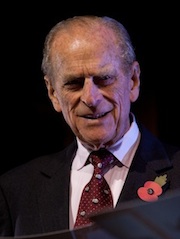HRH Prince Philip's speech, Assisi 2011
 |
 |
 |
Princess Michael of Kent lights a candle at the Sacred Land Celebration to launch the Green Pilgrimage Network, Assisi, Italy. Photograph: Katia Marsh |
This is the speech HRH Prince Philip was planning to deliver to delegates at the launch of the Green Pilgrimage Network in Assisi, Italy, October 31 to November 2011. In the event he was unable to come due to illness but ARC was delighted when HRH Princess Michael of Kent kindly stepped in to read the speech on his behalf.
HRH's speech
In 1986, as International President of the World Wildlife Fund (WWF), I invited five religious leaders from Buddhism, Christianity, Hinduism, Islam and Judaism to join WWF and many other conservation bodies at Assisi in Italy.
The plan was to see how the faiths could work with the conservation movement to protect Nature. It seemed to me that if someone believes that all of life was created by God, this should mean they would feel a sense of responsibility to protect the handiwork of God.
It was much more successful than I could have expected and from this single event has grown what is now the fastest growing conservation movement in the world. From evangelical Christians in the USA through to Muslim leaders in Nigeria or to the Daoists of China, every major faith now has a conservation programme which it is developing in partnership with secular bodies such as the UN or WWF.
 |
| 'It seemed to me that if someone believes that all of life was created by God, this should mean they would feel a sense of responsibility to protect the handiwork of God' - HRH Prince Philip |
|
 |
 |
So significant has this movement become that in 1995 I helped launched a new organisation to help organise the religious conservation movement – the Alliance of Religions and Conservation (ARC).
If I look back over the 25 years since Assisi, I can see not just the number of faiths involved rising from the original five to the present 11 – the Bahá’ís, Jains, Sikhs, Shinto, Taoists and Zoroastrians have joined since the first Assisi – but also the scale of its impact.
 |
| 'Back then it was difficult to find a religious leader who knew the scale of the problems facing Nature. Now it is hard to find a religious leader who doesn’t have something to say about the state of our relationship with Nature' - HRH Prince Philip |
|
 |
 |
Twenty five years ago it was difficult to find a religious leader who knew the scale of the problems facing Nature. Now it is hard to find a religious leader who doesn’t have something to say about the state of our relationship with Nature.
The 'business of religion'
Nor is this just about preaching, important though that is. It is also about what we might describe as ‘the business of religion’. The world’s faiths own about 8% of the habitable surface of the planet – from the urban to some of the most important forests in the world. They run or contribute to 50% of all educational establishments worldwide. They have huge investments in everything from farming to energy.
Perhaps most important of all, they are trusted where many governments and NGOs, are not. They understand the way people think and how to help people change their daily behaviour. The faiths are, after all, the oldest human institutions in the world and you only manage this by understanding how people change and how to build sustainable communities.
 |
 |
 |
ARC's founder HRH Prince Philip |
Today the religious conservation movement, working through literally 100s of different traditions within the major faiths, is the largest such movement in the world. Yet it is still all too often ignored by the mainstream conservation movements. There seems to be a fear that faith means you are opposed to science, a fear fed at times by hardliners – perhaps we could say fundamentalists – on both sides, religious and secular.
The truth is we need each other. Science needs the ability of faith to change lives; faith needs the knowledge of science to understand the nature of the challenges facing us and the planet. Together, as we have seen over the last 25 years, we can achieve so much more than we can apart.
ARC has been the main instrument for building this partnership and its guiding principle has been to ask each faith and each secular organisation to explore its own strengths and then to see how these could work in collaboration with others. When we invited people to the first Assisi in 1986, we asked them to come ‘proud of your own traditions but humble enough to listen’.
A pilgrimage for life
In 1986 my hope was that if the great faiths could find within their teachings and beliefs reasons for protecting Nature, then they could become allies with the conservation movements of the world. Over the last 25 years I have watched the conservation bodies start on the journey of discovering what that can mean.
My hopes have been more than fulfilled, but we still have a long way to go. Tonight we celebrate the first generation of the partnership between religion and conservation. Tonight we start the next generation of that partnership. I invite you all here to join us in what is in truth a pilgrimage for life.
|

